airbag CITROEN NEMO 2014 Handbook (in English)
[x] Cancel search | Manufacturer: CITROEN, Model Year: 2014, Model line: NEMO, Model: CITROEN NEMO 2014Pages: 192, PDF Size: 10.74 MB
Page 5 of 192
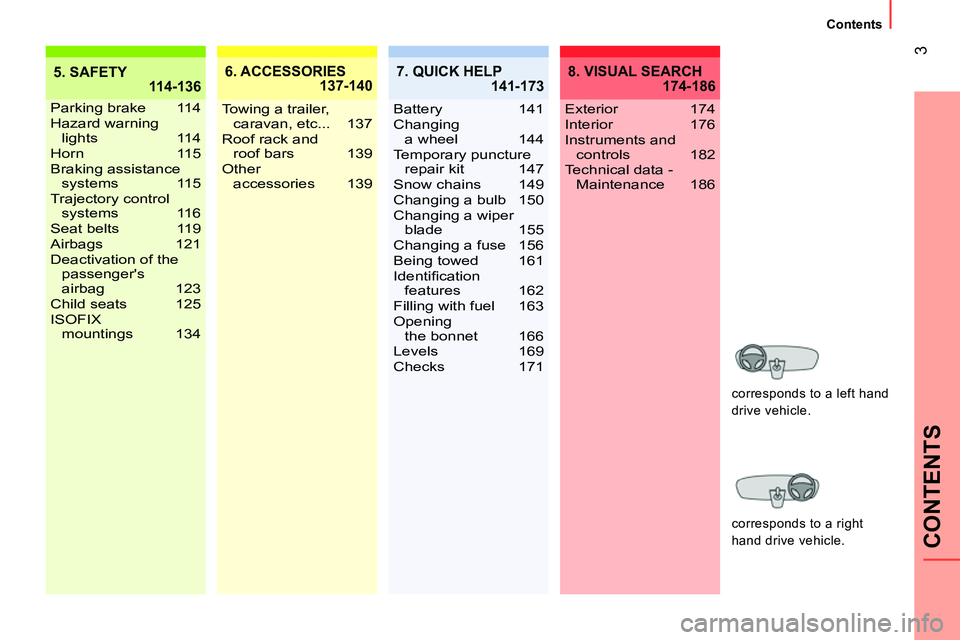
3
CONTENTS
Contents
5. SAFETY
114-1366. ACCESSORIES
137-140
Parking brake 114
Hazard warning
lights 114
Horn 115
Braking assistance
systems 115
Trajectory control
systems 116
Seat belts 119
Airbags 121
Deactivation of the
passenger's
airbag 123
Child seats 125
ISOFIX
mountings 134Towing a trailer,
caravan, etc... 137
Roof rack and
roof bars 139
Other
accessories 139
7. QUICK HELP
141-173
Battery 141
Changing
a wheel 144
Temporary puncture
repair kit 147
Snow chains 149
Changing a bulb 150
Changing a wiper
blade 155
Changing a fuse 156
Being towed 161
Identifi cation
features 162
Filling with fuel 163
Opening
the bonnet 166
Levels 169
Checks 171
8. VISUAL SEARCH
174-186
Exterior 174
Interior 176
Instruments and
controls 182
Technical data -
Maintenance 186
corresponds to a left hand
drive vehicle.
corresponds to a right
hand drive vehicle.
Page 8 of 192
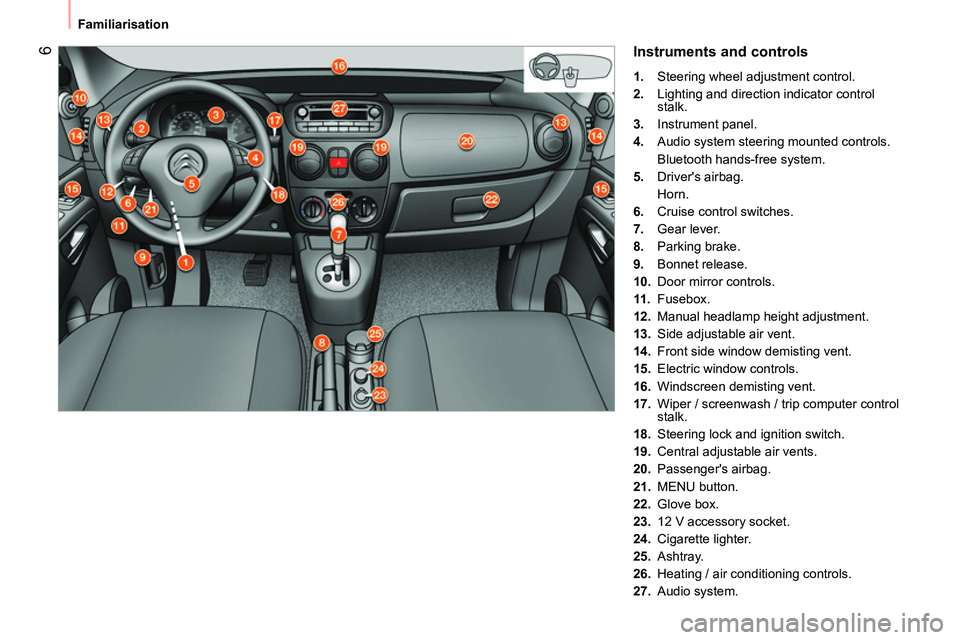
6
Familiarisation
Instruments and controls
1.
Steering wheel adjustment control.
2.
Lighting and direction indicator control
stalk.
3.
Instrument panel.
4.
Audio system steering mounted controls.
Bluetooth hands-free system.
5.
Driver's airbag.
Horn.
6.
Cruise control switches.
7.
Gear lever.
8.
Parking brake.
9.
Bonnet release.
10.
Door mirror controls.
11 .
Fusebox.
12.
Manual headlamp height adjustment.
13.
Side adjustable air vent.
14.
Front side window demisting vent.
15.
Electric window controls.
16.
Windscreen demisting vent.
17.
Wiper / screenwash / trip computer control
stalk.
18.
Steering lock and ignition switch.
19.
Central adjustable air vents.
20.
Passenger's airbag.
21.
MENU button.
22.
Glove box.
23.
12 V accessory socket.
24.
Cigarette lighter.
25.
Ashtray.
26.
Heating / air conditioning controls.
27.
Audio system.
Page 9 of 192
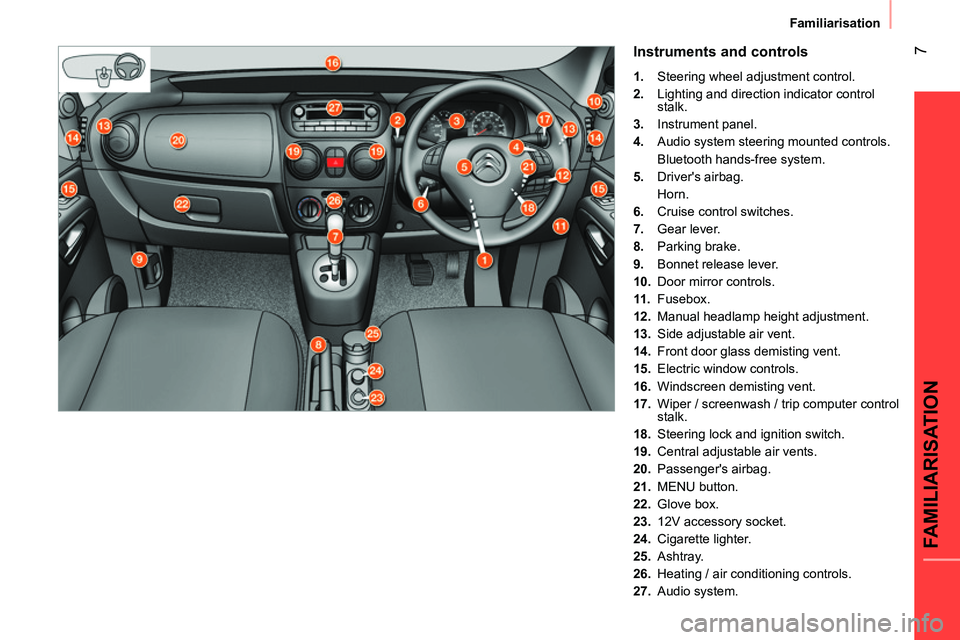
7
FAMILIARISATION
Familiarisation
Instruments and controls
1.
Steering wheel adjustment control.
2.
Lighting and direction indicator control
stalk.
3.
Instrument panel.
4.
Audio system steering mounted controls.
Bluetooth hands-free system.
5.
Driver's airbag.
Horn.
6.
Cruise control switches.
7.
Gear lever.
8.
Parking brake.
9.
Bonnet release lever.
10.
Door mirror controls.
11 .
Fusebox.
12.
Manual headlamp height adjustment.
13.
Side adjustable air vent.
14.
Front door glass demisting vent.
15.
Electric window controls.
16.
Windscreen demisting vent.
17.
Wiper / screenwash / trip computer control
stalk.
18.
Steering lock and ignition switch.
19.
Central adjustable air vents.
20.
Passenger's airbag.
21.
MENU button.
22.
Glove box.
23.
12V accessory socket.
24.
Cigarette lighter.
25.
Ashtray.
26.
Heating / air conditioning controls.
27.
Audio system.
Page 18 of 192

16
Familiarisation
PASSENGER SAFETY
Seat belt not fastened
A.
Driver's seat belt not fastened warning
lamp.
Ladder type vertical partition
(Light van)
A ladder type vertical partition protects the
driver against the risk of load movement. The passenger's front airbag is deactivated by
means of the MENU button, located to the side
of the steering wheel.
1.
Press the MENU button.
2.
Select "Bag" and confi rm by pressing the
MENU button.
3.
Select "OFF" and confi rm by pressing the
MENU button.
4.
Select "YES" and confi rm by pressing the
MENU button.
Passenger's front airbag
11 9 123 109
Page 24 of 192
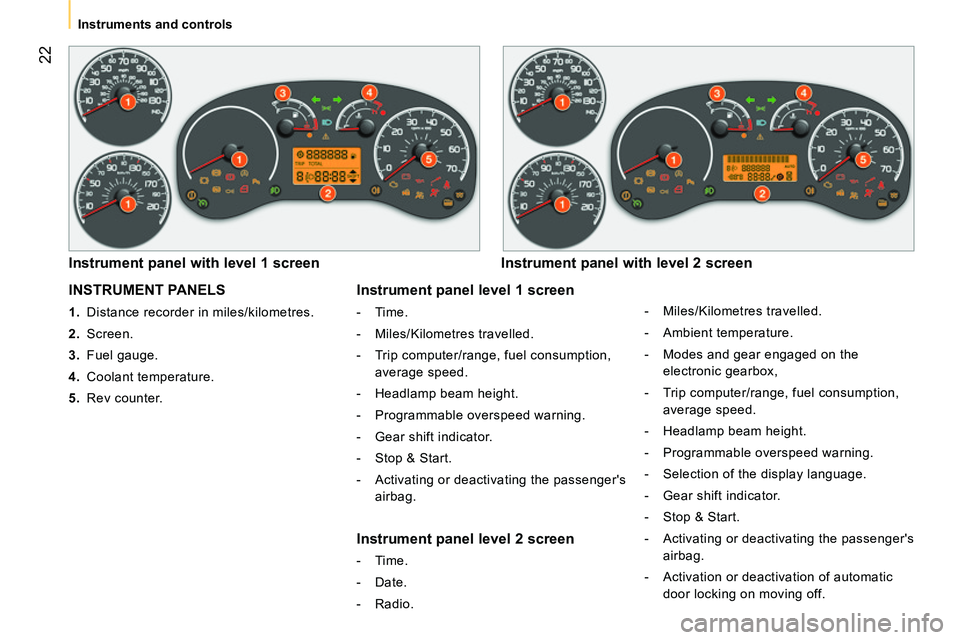
22
Instruments and controls
INSTRUMENT PANELS
1.
Distance recorder in miles/kilometres.
2.
Screen.
3.
Fuel gauge.
4.
Coolant temperature.
5.
Rev counter.
Instrument panel with level 1 screen
Instrument panel with level 2 screen
Instrument panel level 1 screen
- Time.
- Miles/Kilometres travelled.
- Trip computer/range, fuel consumption,
average speed.
- Headlamp beam height.
- Programmable overspeed warning.
- Gear shift indicator.
- Stop & Start.
- Activating or deactivating the passenger's
airbag.
Instrument panel level 2 screen
- Time.
- Date.
- Radio.
- Miles/Kilometres travelled.
- Ambient temperature.
- Modes and gear engaged on the
electronic gearbox,
- Trip computer/range, fuel consumption,
average speed.
- Headlamp beam height.
- Programmable overspeed warning.
- Selection of the display language.
- Gear shift indicator.
- Stop & Start.
- Activating or deactivating the passenger's
airbag.
- Activation or deactivation of automatic
door locking on moving off.
Page 27 of 192
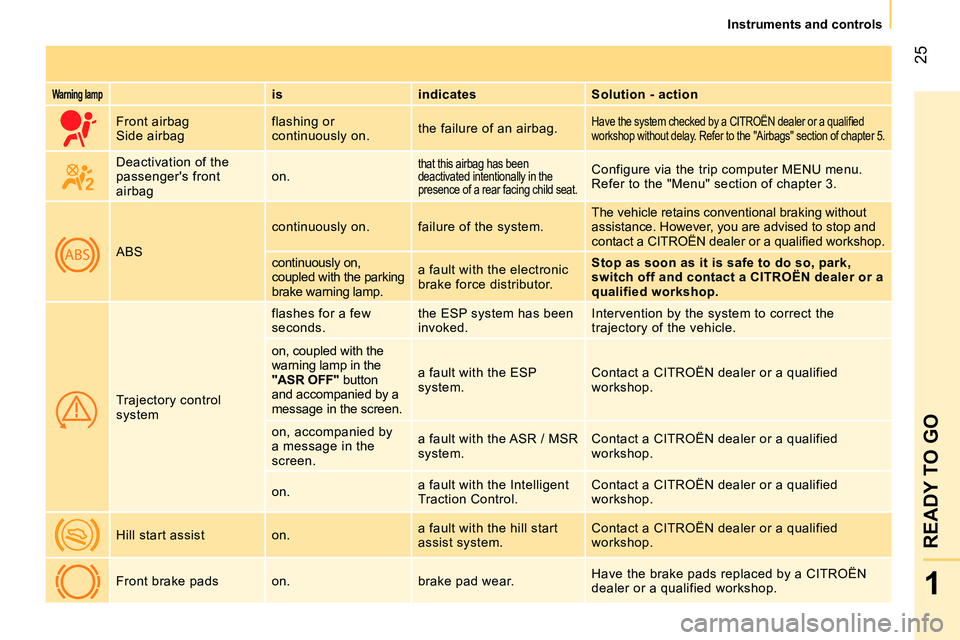
25
1
READY TO GO
Instruments and controls
Warning lamp
is
indicates
Solution - action
Front airbag
Side airbag flashing or
continuously on. the failure of an airbag.
Have the system checked by a CITROËN dealer or a qualifi ed
workshop without delay. Refer to the "Airbags" section of chapter 5.
Deactivation of the
passenger's front
airbag on.
that this airbag has been
deactivated intentionally in the
presence of a rear facing child seat. Configure via the trip computer MENU menu.
Refer to the "Menu" section of chapter 3.
ABS continuously on. failure of the system. The vehicle retains conventional braking without
assistance. However, you are advised to stop and
contact a CITROËN dealer or a qualifi ed workshop.
continuously on,
coupled with the parking
brake warning lamp. a fault with the electronic
brake force distributor.
Stop as soon as it is safe to do so, park,
switch off and contact a CITROËN dealer or a
qualified workshop.
Trajectory control
system flashes for a few
seconds. the ESP system has been
invoked. Intervention by the system to correct the
trajectory of the vehicle.
on, coupled with the
warning lamp in the
"ASR OFF"
button
and accompanied by a
message in the screen. a fault with the ESP
system. Contact a CITROËN dealer or a qualified
workshop.
on, accompanied by
a message in the
screen. a fault with the ASR / MSR
system. Contact a CITROËN dealer or a qualified
workshop.
on. a fault with the Intelligent
Traction Control. Contact a CITROËN dealer or a qualified
workshop.
Hill start assist on. a fault with the hill start
assist system. Contact a CITROËN dealer or a qualified
workshop.
Front brake pads on. brake pad wear. Have the brake pads replaced by a CITROËN
dealer or a qualified workshop.
Page 71 of 192

69
3
TECHNOLOGY on BOARD
Trip computer
TRIP COMPUTER/CONFIGURATION - PERSONALISATION OF THE VEHICLE
If TRIP B is activated in MENU
:
- Trip B,
- Average fuel consumption B,
- Average speed B,
- Trip duration B.
Press the MENU ESC
button for more than
two seconds to return to the home screen.
Level 1 screen:
- Speed (Speed beep).
- Time (Setting the time).
- Buzz (Volume of the announcements).
- Unit (Unit of measurement).
- Bag p (Passenger's airbag).
Refer to the corresponding line of the
configuration - personalisation table on the
following pages.
Zero reset
Press the TRIP
button for more than
two seconds to reset the displayed data to
zero. Using the TRIP
button, located at the end of
the wiper stalk, you can display the following
information in succession:
- Range,
- Trip A,
- Average fuel consumption A,
- Current fuel consumption A,
- Average speed A,
- Trip duration A.
Page 74 of 192

72
Menu
Menu…
Press…
Sub-menu…
Press…
Select…
Confirm
and exit
Enables you to…
10
Volume of
the buttons Increase
Increase/decrease the volume
of the buttons.
Decrease
11
Service (Km/Miles
before oil
change) Display the miles/kilometres
remaining before the next oil
change.
Display the oil level.
12
Bag
(passenger's
airbag) ON Ye s
Activate the passenger's airbag.
No
OFF Ye s
Deactivate the passenger's
airbag.
No
13
Exit from
menu Exit from the menu. Press the
arrow at the bottom to go to the
first menu.
Page 122 of 192

120
Seat belts
Good practice
The driver must ensure that all passengers
fasten their seat belts correctly.
Wherever you are seated in the vehicle,
always fasten your seat belt, even for short
journeys.
The seat belts are fitted with an inertia reel
which automatically adjusts the length of the
strap to your size. The seat belt is reeled in
automatically when not in use.
Ensure that the seat belt has reeled in
correctly after use.
After folding or moving a seat, ensure that
the seat belt has reeled in correctly into its
compartment and that the buckle is ready to
accommodate the tongue. The force limiter reduces the pressure of the
seat belt against the body of the occupants.
The equipment fitted to these seat belts is
operational when the ignition is switched on.
The inertia reels are fitted with a device
which automatically locks the strap in the
event of a collision or emergency braking or
if the vehicle rolls over.
The airbag warning lamp comes
on if the pretensioners are
deployed. Contact a CITROËN or
a qualified workshop.
Depending on the nature and seriousness of
any impact, the pretensioning device may be
deployed before and independently of infl ation
of the airbags. It instantly tightens the seat
belts against the body of the occupants.
The deployment of the pretensioners is
accompanied by a slight discharge of
harmless smoke and a noise, due to the
activation of the pyrotechnic cartridge
incorporated in the system. In order to be effective, a seat belt must:
- restrain one person only,
- must not be twisted, check by pulling in
front of you with an even movement,
- be tightened as close to the body as
possible.
The upper part of the seat belt should be
positioned in the hollow of the shoulder.
The lap part should be placed as low as
possible on the pelvis.
Do not invert the seat belt buckles as they
will not fulfil their role completely. If the
seats are fitted with armrests, the lap part of
the seat belt should always pass under the
armrest.
Check that the seat belt is fastened correctly
by pulling the strap firmly.
Recommendations for children:
- use a suitable child seat if the passenger
is less than 12 years old or less than one
and a half metres tall,
- never allow a child to travel on your lap,
even with the seat belt fastened.
For further information regarding child
seats, refer to the "Children on board"
section of chapter 5.
In accordance with current safety
regulations, for all work on your vehicle,
refer to a qualified workshop that has the
skills an equipment needed, all of which can
be provided by a CITROËN dealer.
Have the seat belts checked regularly (even
after a minor impact) by a CITROËN dealer
or a qualified workshop: they must not show
any signs of wear, cutting or fraying and they
must not be transformed or modified.
Clean the seat belt straps with soapy
water or a textile cleaning product,
available from CITROËN dealers.
Page 123 of 192

121
5
SAFETY
Airbags
AIRBAGS
The airbags have been designed to
maximise the safety of the occupants in the
event of a serious collision; they work in
conjunction with the force limiting seat belts.
In the event of a serious collision, the
electronic detectors record and analyse the
front and side impacts suffered in the impact
detection zones:
- in the event of a serious impact, the
airbags infl ate instantly and contribute
towards best protecting the occupants of
the vehicle. Immediately after the impact,
the airbags defl ate rapidly, so that they do
not hinder the visibility of the occupants
nor their possible exit from the vehicle.
- in the event of a minor or rear impact
and in certain roll-over conditions, the
airbags will not be deployed; the seat belt
alone contributes towards providing your
protection in these situations.
The seriousness of the collision depends on
the nature of the obstacle and the speed of
the vehicle at the moment of impact.
Airbags only operate when the
ignition is switched on.
This equipment only operates once. If a
second impact occurs (during the same or
a subsequent accident), the airbag will not
operate.
The deployment of an airbag or airbags is
accompanied by a slight discharge of smoke
and some noise, due to the activation of the
pyrotechnic cartridge incorporated in the
system.
This smoke is not harmful, but sensitive
individuals may experience some irritation.
The noise of the detonation may result in a
slight loss of hearing for a short time.
It is imperative that the passenger
airbag is deactivated if a child seat is
installed facing rearwards. Refer to "Children
on board" in section 5.